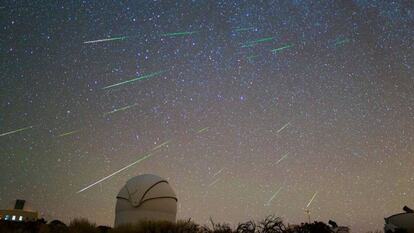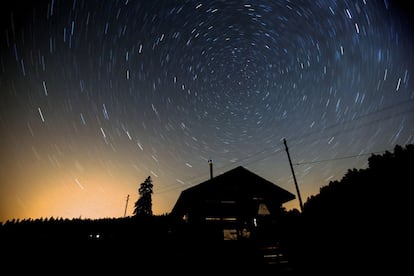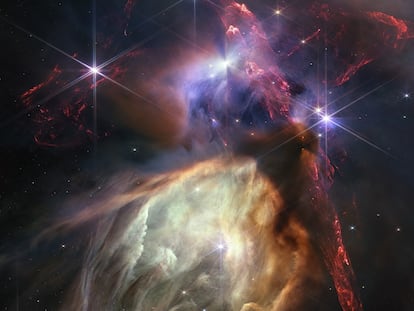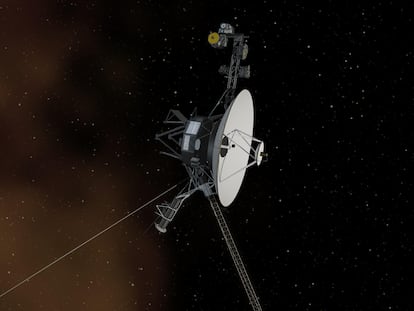Perseids 2023: what the meteor shower tells us about our origins and our future
Aside from being a beautiful spectacle in the August sky, the shooting stars reveal many things about the evolution of the Solar System

I confess: I haven’t looked at the sky very much. This actually is not so rare – there are many professional astrophysicists who are not very fond of looking through a lens or an amateur telescope camera: we go straight to writing commands on a computer and seeing images on DS9 (one of the most used professional programs for astrophysical image visualization). Then there are the astrophysicists who got into this after looking at the starry sky one night in August and enjoying one of the astronomical spectacles that occur sporadically; thanks in part to this repetition, these phenomena teach us a lot about what the universe is like and where we came from.
In a few days we will be able to witness two of these spectacles which invite us to look at the skies. One of the great astronomical events of this summer is the opposition of Saturn, which will take place on August 27. This phenomenon occurs when Saturn, the Earth and the Sun are aligned almost in a straight line, with our planet between the two celestial bodies, the Sun facing one side and Saturn the opposite. It is one of the best moments to observe the most beautiful planet, because its distance from Earth is at a minimum. However, this minimum distance is not always the same; it depends on the year. You will need a telescope to be able to watch Saturn’s rings well.
Before that, an astronomical event that is best observed without binoculars or a telescope will occur: the Perseid meteor shower. For a few days now, the Earth has been passing, in its annual journey, through the trail of material left by a comet known as 109P/Swift-Tuttle. The densest of that cloud of debris will occur sometime around August 12, and we will be crossing it on August 24.
First, some useful information: there will be a crescent moon on that date, and the new moon is on August 16, so 2023 will be a very favorable year to watch the great summer meteor shower. You have to look towards the constellation of Perseus, which will appear before the Moon at about midnight; it will be visible all night long, remaining above the Andromeda galaxy, which is well worth observing with binoculars.
Now some astrophysical data: what we see every year are particles from a cloud left behind by Comet 109P. The P in the names of the comets means that they are periodic; that is, that they have a closed orbit. They travel from the outer zones of the Solar System to the inner ones in periods of less than 200 years. The 109P was discovered in July 1862 by Lewis Swift and Horace Parnell Tuttle (hence its name). It has only come close to us twice since it was identified as a comet; the second time – and the last, so far – was in 1992. The third will be in 2125 and perhaps someone who has already been born will be able to enjoy it. It comes closest to the Sun very close to our orbit and then it goes away, past Pluto (which is 50 times farther from the Sun than Earth). Apparently, the Chinese had already observed this celestial object 23 centuries ago; there is a document (from a Jesuit in China, dated 1737) that mentions a comet that could be this one.
Comet 109P/Swift-Tuttle is unique in several respects. Almost twice the size of the famous Halley’s Comet, it has a highly inclined orbit, that is, very far from the plane in which all the planets move (with fairly small deviations). That plane is known as the ecliptic. If we consider the plane of the ecliptic and the line that joins a body with the Sun at its maximum distance from the plane, we can define the orbital inclination. An inclination of 0 degrees implies that the body moves in the plane of the ecliptic (that is what the Earth does, because its orbit is precisely the one that defines the ecliptic). A 90 degree tilt implies that the orbit is perpendicular to the ecliptic (said to pass through the ecliptic poles). The 109P/Swift-Tuttle has a tilt of almost 114 degrees. This angle greater than 90 degrees means that its orbit is retrograde: it revolves around the Sun in the opposite direction to that of the planets. Comet 109P/Swift-Tuttle only produces one meteor shower each year, while there are others (such as Halley’s) that produce two annual showers, because their orbit intersects that of the Earth at two points.

It is noteworthy that, despite its rather long period, its great inclination and its retrograde orbit, this comet still passes very close to Earth. It is estimated that in 2126 it will pass through the vicinity of Earth’s orbit at the end of July, just 15 days before the Earth passes through roughly the same area, so hopefully the calculations are accurate, because otherwise we will need a hero à la Bruce Willis in Armageddon (1998). However, the calculations are indeed comforting: they indicate that there is no danger that both orbits will coincide in the following millennia.
Where does Comet 109P/Swift-Tuttle come from? Has it been there since the beginning of the Solar System? What is its destiny (and ours)? We don’t have concrete answers, but the comets we have discovered teach us a lot about our origins.
There must be a large number of icy objects (which is what comets are) beyond at least 50 times Pluto’s orbit: between 2,000 and 100,000 times the distance between the Sun and Earth, in what is known as the Oort cloud, which has not been directly observed. In our beginnings, these objects were swept out of the inner parts of the Solar System by Jupiter, perhaps around the same time that the Earth could have received the water of our oceans. Some comets can have very elongated (eccentric) orbits that bring them closer from that deep space to Earth orbit over periods of millennia.
Others may remain in the Oort cloud with stable orbits, and we will never see them approach. And others could be disturbed by nearby massive objects (such as the hypothetical Planet X) and be redirected towards the inner Solar System with open orbits: they will pass by and never return. Some of these may interact with other celestial bodies (especially Jupiter) and end up having a closed orbit, with shorter periods. This last type of comet – periodic – should not last very long (on astronomical scales), because comets lose mass, especially when they pass through the closest point to the Sun. For example, Halley’s will disappear in a few millennia. The fate of these comets (the P type) is to evaporate or collide with another celestial body, as was the case of Comet Shoemaker-Levy, which collided with Jupiter in 1994. That may be our fate.
Perhaps at some point we will come across a type C comet (not periodic, but with an open orbit, which can reach higher speeds), as in the movie Don’t Look Up (2021). May the mention of that apocalyptic fiction serve as an invitation to enjoy the skies, the shooting stars and the rest of the summer worlds, and as a reminder that they will not be there forever.
Sign up for our weekly newsletter to get more English-language news coverage from EL PAÍS USA Edition
Tu suscripción se está usando en otro dispositivo
¿Quieres añadir otro usuario a tu suscripción?
Si continúas leyendo en este dispositivo, no se podrá leer en el otro.
FlechaTu suscripción se está usando en otro dispositivo y solo puedes acceder a EL PAÍS desde un dispositivo a la vez.
Si quieres compartir tu cuenta, cambia tu suscripción a la modalidad Premium, así podrás añadir otro usuario. Cada uno accederá con su propia cuenta de email, lo que os permitirá personalizar vuestra experiencia en EL PAÍS.
¿Tienes una suscripción de empresa? Accede aquí para contratar más cuentas.
En el caso de no saber quién está usando tu cuenta, te recomendamos cambiar tu contraseña aquí.
Si decides continuar compartiendo tu cuenta, este mensaje se mostrará en tu dispositivo y en el de la otra persona que está usando tu cuenta de forma indefinida, afectando a tu experiencia de lectura. Puedes consultar aquí los términos y condiciones de la suscripción digital.
More information
Últimas noticias
Christmas loses its festive spirit: ICE fears cast shadow over religious celebrations
‘Sleepless City’: The light of cinema illuminates Madrid’s Cañada Real shantytown
All the effects of gentrification in one corner of Mexico’s Colonia Roma
Palestinian reporter Youmna El Sayed: ‘My family told me I had to choose between being a journalist or a mother’
Most viewed
- Families demand repatriation of bodies of Colombians who died in Ukraine: ‘This war is a slaughterhouse for foreigners’
- The low-cost creative revolution: How technology is making art accessible to everyone
- Liset Menéndez de la Prida, neuroscientist: ‘It’s not normal to constantly seek pleasure; it’s important to be bored, to be calm’
- Christian Louboutin: ‘Young people don’t want to be like their parents. And if their parents wear sneakers, they’re going to look for something else’
- ‘El Limones’ and the growing union disguise of Mexican organized crime











































